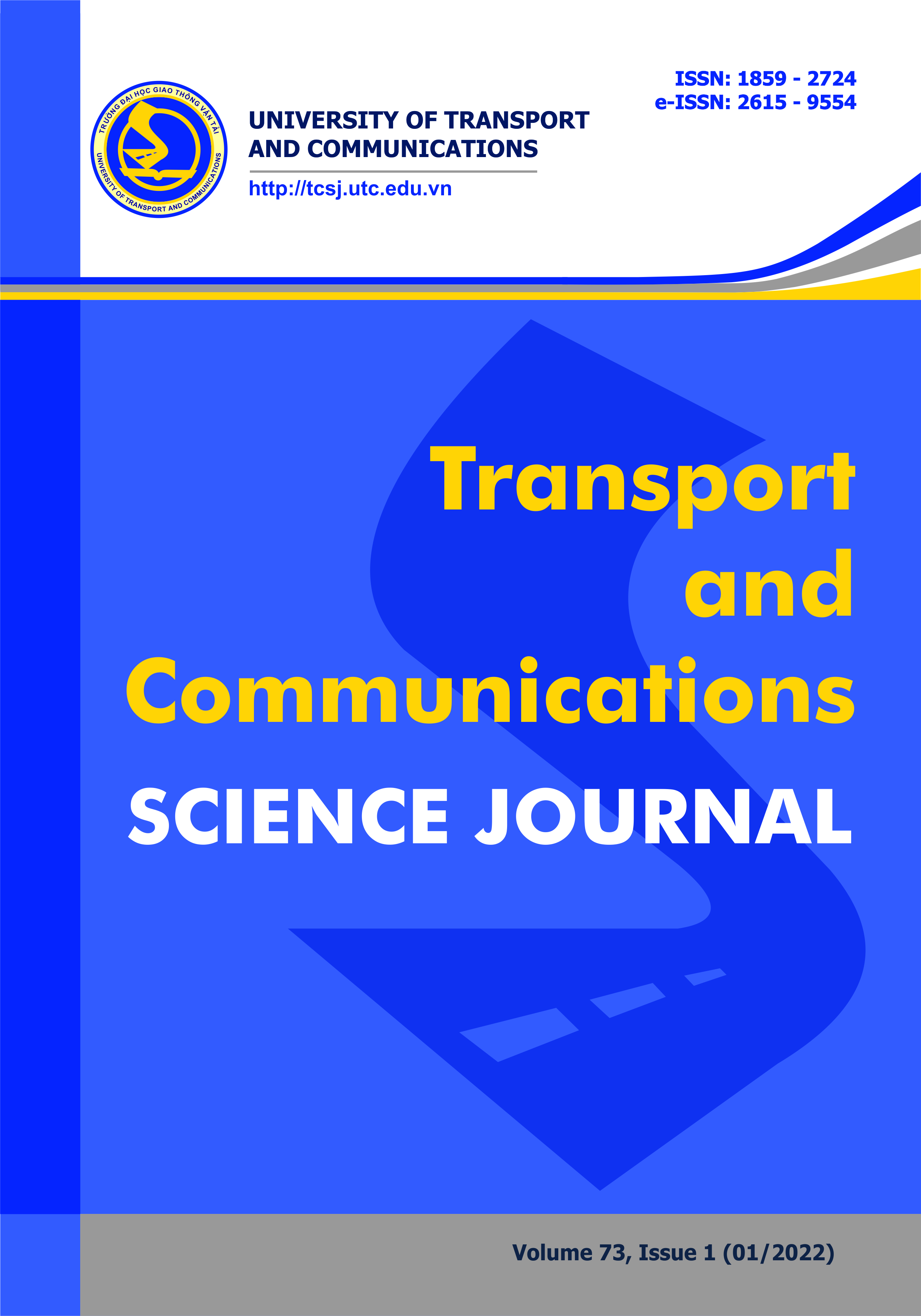Micromechanical approach to determine the effects of surface and interfacial roughness in materials and structure under cosinusoidal normal pressure
Email:
nguyendinhhai.1986@utc.edu.vn
Từ khóa:
contact mechanics, anisotropic materials, Lekhnitskii formalism
Tóm tắt
Contact mechanics is a topic that performs the investigation of the deformation of solids that touch each other at one or more points. A principal distinction in contact mechanics is between stresses acting perpendicular to the contacting bodies' surfaces and stresses acting tangentially between the surfaces. This study focuses mainly on the normal stresses that are caused by applied forces. As a case study, the present work aims at investigating the bi-dimensional contact mechanics of wavy cosinusoidal anisotropic finite planes. To achieve this objective, results on the displacement and stress component are first calculated with the help of the Lekhnitskii formalism. Then, with the application of normal pressure at plane surface and by applying boundary conditions at depth h of solid we obtain solution for the contact pressure in closed form. In case of infinite anisotropic plane where the depth h tends to infinite, by using results obtained with finite h we derive the analytical solution for vertical displacement at the surface. As an illustration, behaviour of a monoclinic material under consinusoidal pressure is analyzedTài liệu tham khảo
[1]. K.L Johnson, Contact Mechanics, Cambridge University Press, USA, 1987.
[2]. K.L. Johnson, K. Kendall, A. D. Roberts, Surface energy and the contact of elastic solids, Procedding of the Royal Society, 324 (1971) 301–313. https://doi.org/10.1098/rspa.1971.0141
[3]. K.L. Johnson, The adhesion of two elastic bodies with slightly wavy surfaces, International Journal of Solids and Structures, 32 (1995) 423–430.
[4]. S. G. Lekhnitskii, Theory of elasticity of an anisotropic body, Mir Publishers, Moscow, 1981.
[5]. N. I. Muskhelishvili, Singular Integral Equations, Groningen, Noordhoff, 1953.
[6]. M.H. Sadd. Elasticity: Theory, Applications, and Numerics, Elsevier Butterworth, Butterworth - Heine- mann, 2005.
[7]. G. F. Carrier, M. Krook , C. E. Pearson, Elasticity: Functions of a Complex Variable: Theory and Technique, Society for Industrial and Applied Mathematics, 2005.
[8]. Q. D. To, Q. C.He, S. T. Nguyen, M. N. Vu, Periodic adhesive contact between an elastic anisotropic layer and a wavy rigid halfspace, international Journal of Solids and Structures, 92-93 (2016) 54–63. https://doi: 10.1016/j.ijsolstr.2016.04.027
[9]. M. Ciavarella, G. Demelio, J. R. Barber, Y.H. Jang, Linear elastic contact of the weierstrass profile, Procedding of the Royal Society, 456 (2000) 387–405. https://doi.org/10.1098/rspa.2000.0522
[10]. K. N. G. Fuller, D. Tabor, The effect of surface roughness on the adhesion of elastic solids. Procedding of the Royal Society, 345 (1975) 327–342. https://doi.org/10.1098/rspa.1975.0138
[11]. J. A. Greenwood, J.B.P Williamson, Contact of nominally flat surfaces, Procedding of the Royal Society, 295 (1966) 300–319. https://doi:10.1098/rspa.1966.0242
[12]. T.C.T. Ting, Anisotropic Elasticity, Theory and applications, Oxford University Press, New York, 1996. https://doi:10.1093/oso/9780195074475.001.0001
[13]. D.C. Pham, Bounds on the Elastic Moduli of Completely Random Two-Dimensional Polycrystal, National Center for Natural Science and technology, Institute of Mechanics, Hanoi (2002).
[2]. K.L. Johnson, K. Kendall, A. D. Roberts, Surface energy and the contact of elastic solids, Procedding of the Royal Society, 324 (1971) 301–313. https://doi.org/10.1098/rspa.1971.0141
[3]. K.L. Johnson, The adhesion of two elastic bodies with slightly wavy surfaces, International Journal of Solids and Structures, 32 (1995) 423–430.
[4]. S. G. Lekhnitskii, Theory of elasticity of an anisotropic body, Mir Publishers, Moscow, 1981.
[5]. N. I. Muskhelishvili, Singular Integral Equations, Groningen, Noordhoff, 1953.
[6]. M.H. Sadd. Elasticity: Theory, Applications, and Numerics, Elsevier Butterworth, Butterworth - Heine- mann, 2005.
[7]. G. F. Carrier, M. Krook , C. E. Pearson, Elasticity: Functions of a Complex Variable: Theory and Technique, Society for Industrial and Applied Mathematics, 2005.
[8]. Q. D. To, Q. C.He, S. T. Nguyen, M. N. Vu, Periodic adhesive contact between an elastic anisotropic layer and a wavy rigid halfspace, international Journal of Solids and Structures, 92-93 (2016) 54–63. https://doi: 10.1016/j.ijsolstr.2016.04.027
[9]. M. Ciavarella, G. Demelio, J. R. Barber, Y.H. Jang, Linear elastic contact of the weierstrass profile, Procedding of the Royal Society, 456 (2000) 387–405. https://doi.org/10.1098/rspa.2000.0522
[10]. K. N. G. Fuller, D. Tabor, The effect of surface roughness on the adhesion of elastic solids. Procedding of the Royal Society, 345 (1975) 327–342. https://doi.org/10.1098/rspa.1975.0138
[11]. J. A. Greenwood, J.B.P Williamson, Contact of nominally flat surfaces, Procedding of the Royal Society, 295 (1966) 300–319. https://doi:10.1098/rspa.1966.0242
[12]. T.C.T. Ting, Anisotropic Elasticity, Theory and applications, Oxford University Press, New York, 1996. https://doi:10.1093/oso/9780195074475.001.0001
[13]. D.C. Pham, Bounds on the Elastic Moduli of Completely Random Two-Dimensional Polycrystal, National Center for Natural Science and technology, Institute of Mechanics, Hanoi (2002).
Tải xuống
Chưa có dữ liệu thống kê

Nhận bài
23/07/2021
Nhận bài sửa
10/09/2021
Chấp nhận đăng
21/10/2021
Xuất bản
15/01/2022
Chuyên mục
Công trình khoa học
Kiểu trích dẫn
Nguyen Dinh, H. (1642179600). Micromechanical approach to determine the effects of surface and interfacial roughness in materials and structure under cosinusoidal normal pressure. Tạp Chí Khoa Học Giao Thông Vận Tải, 73(1), 31-39. https://doi.org/10.47869/tcsj.73.1.3
Số lần xem tóm tắt
273
Số lần xem bài báo
495









